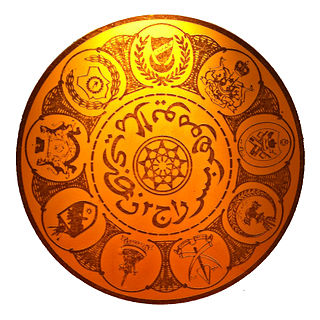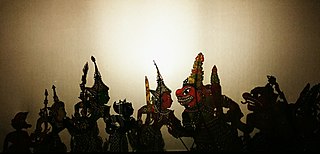
Gamelan is the traditional ensemble music of the Javanese, Sundanese, and Balinese peoples of Indonesia, made up predominantly of percussive instruments. The most common instruments used are metallophones played by mallets and a set of hand-played drums called kendhang which register the beat. The kemanak and gangsa are commonly used gamelan instruments in Java. Other instruments include xylophones, bamboo flutes, a bowed instrument called a rebab, siter, and even vocalists named sindhen (Female) or Gerong (Male).

Silat Melayu, also known as Seni Persilatan Melayu or simply Silat, is a combative art of self-defence from the Malay world, that employs langkah ('steps') and jurus ('movements') to ward off or to strike assaults, either with or without weapons. Silat traced its origin to the early days of Malay civilisation, and has since developed into a fine tradition of physical and spiritual training that embodies aspects of traditional Malay attire, performing art and adat. The philosophical foundation of modern Malay Silat is largely based on the Islamic spirituality. Its moves and shapes are rooted from the basis of Silat movements called Bunga Silat, and Silat performances are normally accompanied with Malay drum assembles.

Perlis, also known by its honorific title Perlis Indera Kayangan, is the smallest state in Malaysia. It lies at the northern part of the west coast of Peninsular Malaysia and has the Satun and Songkhla Provinces of Thailand on its northern border. It is bordered by the state of Kedah to the south. It was called Palit by the Siamese when it was under their influence. Perlis had a population of 227,025 as of the 2010 census.

Al-Sultan Al-Mu’tassimu Billahi Muhibbuddin Tuanku Al-Haj Abdul Halim Mu'adzam Shah ibni Almarhum Sultan Badlishah was the 28th Sultan of Kedah, reigning from 1958 to 2017. He served as the fifth Yang di-Pertuan Agong of Malaysia from 1970 to 1975, and as the 14th Yang di-Pertuan Agong from 2011 to 2016. He was the first person to reign as Yang di-Pertuan Agong twice, as well as the oldest elected to the office. Immediately prior to his death, he was the second longest-reigning living monarch in the world after Queen Elizabeth II of the United Kingdom.
Brunei is a southeast Asian country located on Borneo between the states of Sabah and Sarawak which are part of Malaysia. There is a wide array of native folk music, and dance. Brunei shares some Cultural perspectives and links with the countries of South East Asia such as Malaysia, Singapore, Indonesia, Thailand, Philippines. The strong Islamic influence means that dance performances and music are somewhat restricted.

Alor Setar, known as Alor Star from 2004 to 2008, is the state capital of Kedah, Malaysia. It is the second-largest city in the state after Sungai Petani and one of the most-important cities on the west coast of Peninsular Malaysia. It sits along the country's longest expressway, located 400 km (250 mi) from Kuala Lumpur and 79 km (49 mi) north of George Town, Penang. The city is home to the Central State Administration Centre and is the administrative centre of Kota Setar District.

The Semai are a semi-sedentary ethnic group living in the center of the Malay Peninsula in Southeast Asia, known especially for their nonviolence. They speak Semai, an Austroasiatic language closely related to Temiar, spoken by Temiars nearby. The Semai are bordered by the Temiars to the north and the Jah Hut to the South. The Semai belong to the Senoi group, and are one of the largest indigenous ethnic group in the Peninsula and the largest of the Senoi group. Most Semai subsist by cultivating grain crops, hunting, and fishing.

The term "British Malaya" loosely describes a set of states on the Malay Peninsula and the island of Singapore that were brought under British hegemony or control between the late 18th to the mid-20th century. Unlike the term "British India", which excludes the Indian princely states, British Malaya is often used to refer to the Federated and Unfederated Malay States, which were British protectorates with their own local rulers, as well as the Straits Settlements, which were under the sovereignty and direct rule of the British Crown, after a period of control by the East India Company.

Mak Yong is a traditional form of dance-drama from northern Malaysia, particularly the state of Kelantan. It was banned by the Pan-Malaysian Islamic Party because of its animist and Hindu-Buddhist roots which pre-date Islam in the Asian region by far. The late Cik Ning was a leading Mak Yong performer in the 1980s. In 2005, UNESCO declared Mak Yong theatre a "Masterpieces of the Oral and Intangible Heritage of Humanity".
The regalia of Malaysia includes all the items which are deemed sacred and symbolic of the supremacy and authority of the Yang di-Pertuan Agong or the Supreme King of Malaysia and his consort, the Raja Permaisuri Agong. The installation of the Supreme King is a very special ceremony. Only on this particular day are the masses able to see his regalia. Several of these are Malaysian National Treasures since 2009.

The Malaysian Siamese or Thai Malaysians are an ethnicity or community principally originated in Northern Peninsular Malaysia which is a relatively homogeneous cultural region to Southern Burma and Southern Thailand but was separated by the Anglo-Siamese Treaty of 1909 between the United Kingdom and the Kingdom of Siam. The treaty established the modern Malaysia-Thailand Border which starts from Golok River in Kelantan and ends at Padang Besar in Perlis. In 2014, there were nearly 70,000 people self-identifying as "Siamese" or "Thai" who held Malaysian nationality. This number excludes the senior citizen Siamese who live in Malaysia but do not hold Malaysian citizenship because of political constraint.

The Malay gamelan is a style of music performed in Indonesia and Malaysia.

Kedahan Malay or commonly known as Orang Utara, is a sub-group of Malays that is native to Northern Malaysia and in southernmost parts of Thailand and Burma. They are among the earliest settlers in the Malay peninsula. Kedahan Malays comprised at least 15% of the total Malaysian Malay population.

Baju Kurung is a traditional costume originated from Sumatra, and Malay peninsula, and is traditionally worn by women in Brunei, Indonesia, Malaysia, Singapore and southern Thailand. This type of traditional costume is the national dress of Brunei and Malaysia. In Indonesia, it is also one of the regional dresses, seen most on the island of Sumatra, where many ethnic Malay and Minangkabau women wear it.
Mak Inang is a traditional Malay dance that originated from the time of Malacca Sultanate. The dance is accompanied by a unique music which is believed to have been composed by the order of Sultan Mahmud Shah of Malacca.
Mek Mulung is a traditional Malay theatre that unique to the northwest state of Kedah in Malaysia. It became popular since the late 18th century and incorporates most elements of Mak Yong, Menora and Hadrah. The theatre features a repertoire of stories from local legends, which according to a source, amounted about 20 original stories, with few of them survived today. Similar to Mak Yong, the stories are presented through dialogue, song and dance.

The monarchies of Malaysia refer to the constitutional monarchy system as practised in Malaysia. The political system of Malaysia is based on the Westminster parliamentary system in combination with features of a federation.

Kedah United FC is a Malaysian football team based in the city of Alor Setar representing the state of Kedah, Malaysia. Newly founded in 2012, the team were registered under the name of the Kedah Malays Football Association (KMFA).

Malaysian folklore is the folk culture of Malaysia and other indigenous people of the Malay archipelago as expressed in its oral traditions, written manuscripts and local wisdoms. Malaysian folklores were traditionally transmitted orally in the absence of writing systems. Oral tradition thrived among the Malays, but continues to survive among Orang Asli and numerous bornean ethnic groups in Sarawak and Sabah. Nevertheless, Malaysian folklores are closely connected with classical Malay folklore of the region. Even though, Malay folklore tends to have a regional background, with the passing of time, and through the influence of the modern media, large parts of regional Malay folklore have become interwoven with the wider popular Malaysian folklore.

Traditional Malaysian art is primarily composed of Malay art and Bornean art, is very similar with the other styles from Southeast Asia, such as Bruneian, Indonesian and Singaporean. Art has a long tradition in Malaysia, with Malay art that dating back to the Malay sultanates, has always been influenced by Chinese, Indian and Islamic arts, and also present, due to large population of Chinese and Indian in today's Malaysian demographics.
















